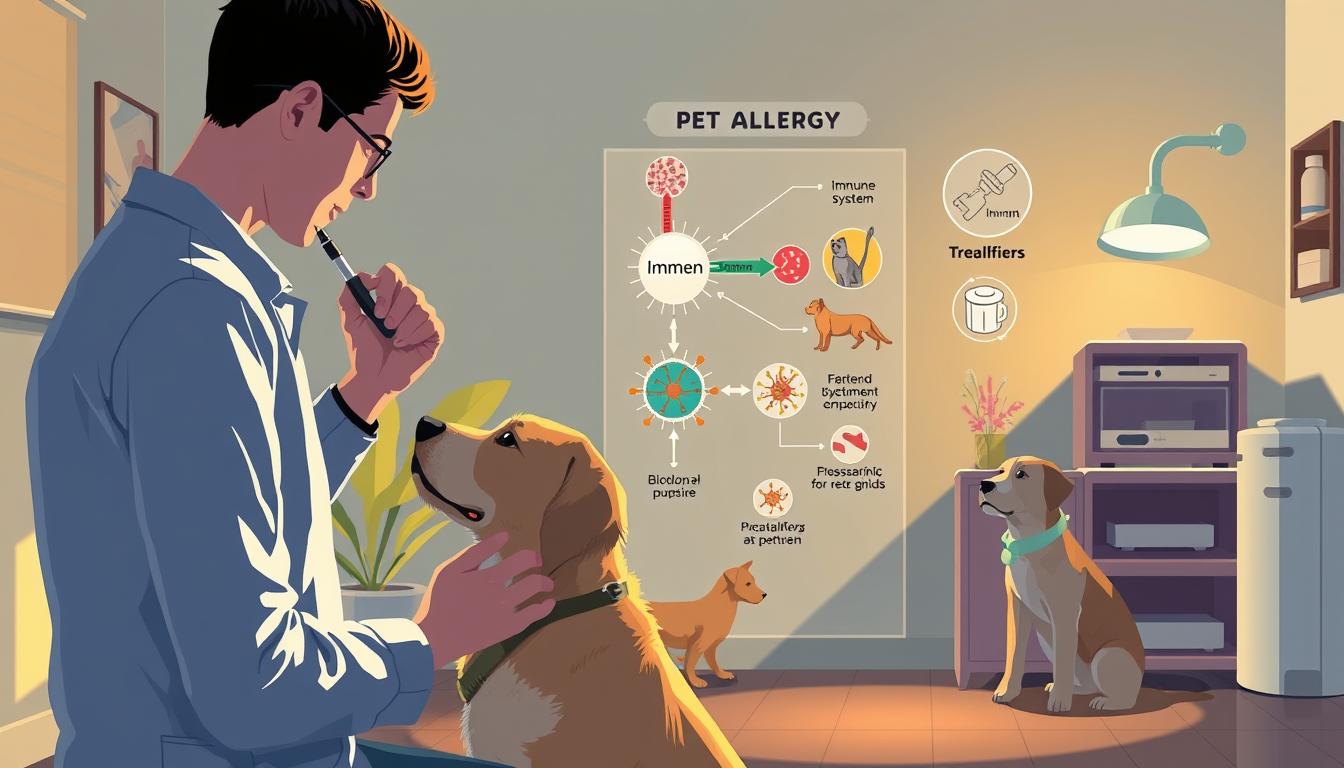Imagine your dog scratching nonstop, their fur covered in tiny specks. You wonder, is it fleas or ticks? This is every pet owner’s nightmare. It’s not just about avoiding bites; it’s about keeping them safe from diseases and discomfort.
With so many options, finding the right flea & tick treatment can be tough. But it doesn’t have to be.
Every pet needs protection that fits them. This guide helps you find the best flea & tick treatments for your pet. We’ll cover size, age, and health concerns. You’ll learn what works, why it’s important, and how to avoid mistakes.
Your peace of mind and your pet’s health begin here.
Understanding Flea and Tick Threats to Your Pet
Keeping your pet safe from fleas and ticks is more than just keeping them comfortable. It’s about keeping them alive. These pests can spread diseases that harm your dog’s health or make your cat very sick. It’s important to know the risks and choose the right protection for your pet.
Fleas can make dogs anemic from losing too much blood. Ticks can give cats Lyme disease and other serious illnesses. Dogs might scratch a lot, but cats might hide their symptoms. If not treated, these pests can cause skin infections and allergic reactions.
Constant scratching or biting at their skin
Red, irritated patches or hair loss, usually near ears or tail
Small black specks (flea dirt) in fur or bedding
Lethargy, loss of appetite, or fever
Visible ticks attached to the skin
Use a fine-tooth comb on your pet weekly. Brush onto a damp paper towel. Flea dirt turns red when wet, showing you have an infestation.
Even in cold winters, fleas can survive. Indoor heat and short walks outside can expose pets to ticks. It’s vital to use flea treatment or tick prevention all year. Skipping months can lead to outbreaks when it gets warmer.
Best Flea & Tick Treatments: Which One Works Best?
Finding the best flea medication or top-rated flea treatment depends on your pet’s lifestyle. Let’s break down today’s top options:
- Topical treatments like Frontline Plus or Advantage Multi kill fleas on contact and protect against other parasites. Apply monthly for waterproof options if your dog loves swimming.
- Oral medications such as NexGard chewables work fast—often within 8 hours—and last 30 days. These are ideal for pets sensitive to topical solutions.
- Collars like Seresto release active ingredients over 8 months. Perfect for multi-pet homes, they protect against fleas, ticks, and mosquitoes.
Ask your vet about ingredients like fipronil or spinosad for active infestations. For prevention, look for broad-spectrum formulas that also guard against heartworm. Some top-rated flea treatment brands combine convenience with long-lasting protection. Remember: what works for a small cat might not suit an outdoor hunting dog. Start with your vet’s recommendation and adjust based on how your pet reacts.
Check for discounts on multi-packs to save costs over time. Need quick relief? Oral meds often act fastest. Prefer hands-off solutions? Collars require no daily application. Every pet’s needs are unique—so is their perfect match.
Comparing Different Types of Flea and Tick Solutions
Choosing the right flea and tick solution depends on your pet’s lifestyle and your preferences. Let’s break down the options to help you decide what works best.

Topical Treatments: Pros and Cons
Spot-on treatments, like Frontline Plus or Advantage II, work by absorbing into your pet’s skin oils. These deliver 30 days of protection and often stay effective even after swimming. But always keep treated areas away from children’s hands and mouths.
- Pros: Long-lasting, waterproof
- Cons: Require direct skin contact, potentially greasy residue
Oral Medications: Effectiveness and Considerations
Chewable tablets, such as NexGard or Bravecto, kill parasites systemically. They act fast but check with a vet if your pet has liver issues or is a sensitive breed like a greyhound. These are ideal for active pets who dislike topical applications.
Collars, Shampoos, and Sprays: When to Use Each
Use Seresto collars for 8 months of slow-release protection. Shampoos like Sergeant’s Pet Care work during baths but only kill existing pests. Sprays, such as Adams Plus II, help decontaminate environments. Combine these for layered defense.
Natural and Chemical-Free Alternatives
Opt for natural flea and tick repellent options like Wondercide essential oil sprays or food-grade diatomaceous earth for home use. Neem oil shampoos can repel pests, but always test small areas first. Note: Some natural products may not match chemical treatments in speed or strength.
How to Choose the Right Treatment for Your Specific Pet
Finding the best flea & tick treatments for your pet begins with knowing their needs. The right prevention tips depend on your pet’s type, age, and lifestyle. Let’s look at the key factors to consider:
- Pet type: Dogs and cats need their own formulas. Never mix products—cat-safe options like Advantage II are critical for felines.
- Age and size: Puppies, kittens, and small breeds need special dosing. Always check the weight ranges on labels for safety.
- Breed traits: Some breeds, like Collies, may react to certain flea medications. Ask your vet about genetic sensitivities.
- Outdoor habits: Active dogs who swim or hike need water-resistant options. Oral chews like NexGard or collars like Seresto stay effective even after baths.
- Health conditions: Pets with allergies or arthritis may prefer spot-on treatments or oral meds over topical solutions.

For example, senior pets with sensitive skin do well with Bravecto, a chewable option from the best flea & tick treatments that lasts 12 weeks. Dogs who swim weekly might need monthly applications of Revolution, which stays effective after water exposure. Multi-pet homes should ensure all pets use compatible products to avoid cross-reactions.
Always talk to your vet before switching treatments. Start with small doses and watch for redness, lethargy, or appetite loss. Combining flea and tick prevention tips with vet guidance ensures safety and effectiveness. With the right choices, you’ll protect every member of your family—two-legged and four-legged alike.
Proper Application Methods for Maximum Protection
Getting the most out of your flea and tick control products starts with proper application. Small details like timing and technique can make all the difference in keeping your pet safe. Here’s how to avoid common pitfalls and boost protection:
Timing Your Treatments for Optimal Results
Stick to the schedule recommended by your vet. Set calendar alerts for reapplication dates. For new pets, start treatments immediately—even before introducing them to other animals. Treat all pets in your home at the same time to stop infestations from spreading.
Common Application Mistakes to Avoid
- Applying too soon after a bath: Wait at least 24 hours after washing your pet before using topical flea and tick control products.
- Ignoring weight guidelines: Use dosing charts for oral medications. Underdosing leaves gaps in protection.
- Skipping skin contact: Part fur to place topical treatments directly on the skin, not just on the fur.
Combining Treatments Safely
Pair oral medications with collars for layered protection—just ask your vet first. Never mix two topical products at once. Overloading with multiple flea and tick control products can cause toxicity. Always check labels for warnings about combining treatments.
Creating a Complete Flea and Tick Defense Strategy for Your Home
Protecting your pets is just the start to fight fleas and ticks. You need a mix of prevention tips for pets and home strategies for lasting control. Begin by vacuuming floors and pet spots weekly, focusing on cracks and carpets where eggs hide. Also, wash your pet’s bedding and toys in hot water every two weeks to kill larvae.
For pet-safe cleaning, use sprays or natural repellents like diatomaceous earth in tough spots. Outside, keep your lawn short and clear leaf piles where ticks like to hide. Use cedar chips or nematodes around your home to naturally keep insects away. For flower beds, sprinkle diatomaceous earth to disrupt pest habitats.
Regularly check outdoor play areas for tick hotspots and treat them with EPA-approved products in spring and fall. Seasonal changes are important. In summer, use safe essential oils like lavender or citronella in diffusers to repel insects. During fall, seal gaps where pests can enter.
Keep track of your efforts with a maintenance calendar. Note down monthly vacuuming, quarterly yard checks, and seasonal product changes. Consistency is key to breaking the flea cycle. Treating both your pets and their environment stops infestations early.























